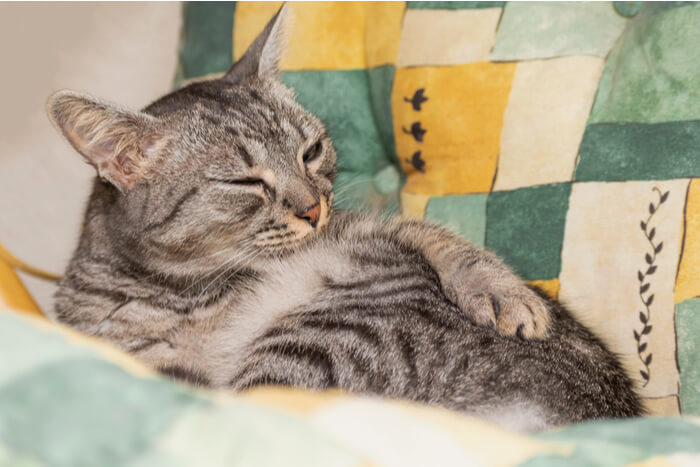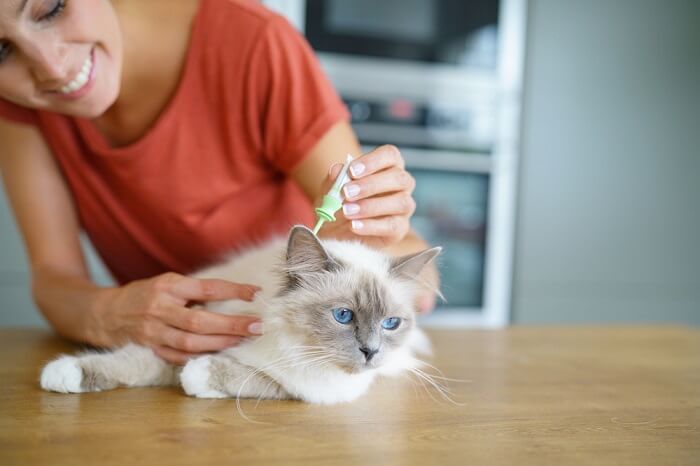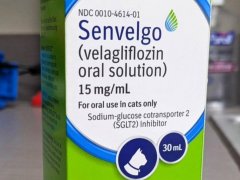
Cheristin is a once a month topical flea treatment solution developed by Elanco Animal Health for killing adult fleas in cats. In this article, you’ll learn what Cheristin for cats is, how it works, potential side effects to watch for, and some frequently asked questions.
Cheristin for Cats Overview

About Cheristin for Cats

Cheristin is the brand name for the drug spinetoram, which is approved for use in cats to kill adult fleas.
According to the manufacturer, a single dose of Cheristin for cats begins to kill adult fleas within 30 minutes, with a study showing 98-100% of fleas being killed within 12 hours.
Also Read: Cat Fleas: Identification, Life Cycle, and Treatment
Cheristin affects only adult fleas and does not have any direct action against any other life stages, including flea eggs and flea larvae. However, with continued monthly use, any newly hatching or developing fleas will continue to be killed, eventually eliminating a home infestation in addition to environmental measures.
Also Read: How To Get Rid Of Fleas On Your Cat
Cheristin does not appear to have any efficacy against any parasites other than fleas, including ticks or ear mites. As it is only absorbed topically in the skin, it has no efficacy against internal parasites like intestinal worms or heartworms.
Also Read: Cat Intestinal Parasites: Causes, Symptoms, & Treatment
What Does Cheristin Do for Cats?

Flea allergies are a common cause of skin irritation and hair-pulling in cats.
Spinetoram works on two different neurotransmitters in insects it is effective against, GABA and acetylcholine. GABA is an inhibitory neurotransmitter while acetylcholine is responsible for many nervous system functions including muscle movement.
When spinetoram acts against both GABA and acetylcholine, this leads to overstimulation of the nervous system of the flea, followed by paralysis and death.
While monthly application of the topical solution is advised by the manufacturer for flea control, a study did show that Cheristin was effective against adult fleas for up to 6 weeks.
Side Effects of Cheristin for Cats

Like virtually all medications, Cheristin may cause certain side effects. The most commonly-reported side effects include hair loss, redness, and itchiness at the application site.
Cheristin is only labeled for cats and kittens older than 8 weeks of age and weighing more than 1.8lb.
The most common side effects reported in cats include application site reactions, including hair loss, redness, or itching at the application site. Vomiting and inappetence were also less commonly reported.
Cheristin is not supposed to be ingested. Care needs to be taken with any topical product to apply it at the base of the neck, just in front of the shoulder blades, as this is an area a cat cannot reach to groom herself or lick the product off.
According to DVM360’s article “Toxicology Brief: The 10 most common toxicoses in cats” this effect is typically not a true toxicity, but a sometimes dramatic reaction to the bitter taste. Providing milk or liquid from a tuna can help resolve the signs in short order.
In multiple cat households, kitty housemates should not be allowed to groom each other after Cheristin application until the product is dry. While no information is available for how long this takes specifically for Cheristin, it is commonly recommended to keep pets separated for 24 hours after application of a topical product.
Limited data is available for Cheristin’s use in pregnant animals and it was not tested in lactating animals, so it should be used very cautiously in pregnant or lactating queens.
If you have any concerns for potential toxicity, even if you think your kitty might have just licked some Cheristin off her fur and is having a bitter taste reaction, it is always best to contact your veterinarian, the ASPCA Animal Poison Control Center, or Pet Poison Helpline for further advice.
Can Cheristin for Cats Be Used on Dogs?

Cheristin is not intended for use in dogs. Dogs, in fact, appear to have a sensitivity to spinetoram, so for any readers with pups at home, always take care to apply the correct products on your pets at home and make sure your pup cannot lick off Cheristin recently applied on your cat.
Cheristin for Cats Dosage

Cheristin is unique in that it is a one-size-fits-all product. As long as your cat is over 1.8lb, one vial of Cheristin is the appropriate dose.
Cheristin is unique, as it’s a one size fits all product!
There is only one dosage for Cheristin for cats, regardless of weight, as long as a cat is over 1.8lb. Even for cats over 20lb, the manufacturer stresses that only one vial should be used.
How to Apply Cheristin for Cats

To apply Cheristin, the cap of the applicator vial must first be pressed down until a “click” is heard to indicate the vial has been punctured. The cap is then removed.
The fur over an area at the back of the neck, just in front of the shoulders should be selected and prepared. This ensures that a kitty cannot lick the product off of himself.
Placing the tube directly above the skin, squeeze the tube 2-4 times to ensure all product has been squeezed out.
The manufacturer states that a small amount of liquid may remain in the vial after application, which is normal.
Does Cheristin for Cats Work

Cheristin for cats is a decent product to consider for treating a cat for fleas. It has only a single dose size, which can be useful in households that have cats of different weights.
It also works fast to kill adult fleas. However, it has a very narrow range of treatment as it only targets adult fleas, which may take a little longer to address a flea infestation in the home compared to a product that targets all flea life stages.
Drug Dosing Disclaimer: We are only able to provide doses for medications that are FDA approved for use in cats and only as the label guidelines dictate. For medications that are used off-label we can only provide guidelines and safety information for use. Safe and appropriate dosing for off-label medications can only be determined by a primary care veterinarian.
We encourage you to work with your veterinarian to determine if a particular medication is appropriate for your cat. Changing or adjusting a dose for your cat on your own without consulting with a veterinarian can carry risk. We do not encourage use of medications prescribed for human use in pets without first consulting with a primary care veterinarian.
Frequently Asked Questions
Does Cheristin for Cats Work?
Cheristin appears to have good efficacy against adult fleas.
However, the question of flea or tick resistance to these products and the idea that they don’t work comes up often. The 2017 article “Perception vs. Reality: Insecticide Resistance in Fleas” from DVM360 that refers to an article published in American Veterinarian that same year addresses this topic.
An entomology (“bug science”) professor from the University of California heavily investigated this question and concluded that while resistance has been seen to some flea treatment or prevention products, true chemical resistance in fleas with fipronil, imidacloprid, and some other newer products on the market has not yet been demonstrated.
In many cases, when a pup or kitty parent is still seeing live fleas on their pet after a product has been applied, this issue can most often be traced back to incorrect use or application of the product, as well as poor expectations.
Following are some common errors or misperceptions:
- Incorrect application (i.e. applied to the fur not the skin, failing to apply the whole volume of product, failure to properly puncture or open a vial prior to application)
- Failure to apply to all pets in the household. If one pet brings fleas indoors, they can jump onto all pets in the home. If all pets are not treated at the same time, flea infestations can persist.
- Bathing. Baths are a common go-to, especially when live fleas are seen. However, like many topical flea products, Cheristin likely needs 24 hours to spread throughout the oils on the skin. Bathing shortly before or after application removes oils from the skin as well as possibly the product itself.
- Not Treating Long-Enough. It can sometimes take as long as 3 months to clear out a flea infestation. So while most veterinarians advise year-round protection against fleas and ticks, a product like Cheristin should be used every month for at least 3 months during an active infestation. Flea eggs not cleared from the home environment are likely to continue hatching every couple of weeks, meaning a kitty that received only one monthly dose of Cheristin can get infested again a few weeks later if the dose is not repeated the next month.
- Not Treating Year-Round. Fleas have been known to over-winter indoors. Treating pets for only certain months of the year can leave open gaps in prevention for infestations to occur.
- Failing to Treat the Environment. Because one flea can lay up to 50 eggs in just one day, the amount of eggs in a home environment with fleas can be staggering. If the environment is not treated effectively, continually hatching fleas may continue to be found on a treated pet.
- Perceiving Products as Repellents. Always remember that most topical products like Cheristin do not have repellency action, meaning that fleas and ticks must come in contact with the skin to be killed. Heavily-infested outdoor areas as well as poorly-treated indoor infestations can be sources for large numbers of adult fleas to “suddenly” appear on a treated pet.
- Cheristin Makes Fleas Hyper. Cheristin’s action against the neurological pathways of fleas causes them to become hyper excited before dying. This means you may actually view more of them initially after application as they jump to the surface of a kitty’s furry coat.
- If You Still Think There’s a True Product Issue. If you feel you have applied a product properly and are addressing a flea infestation according to your vet’s instructions and still feel that a product is not working well, make sure to bring those concerns to your vet or contact the manufacturer of the product.
Does Cheristin for Cats Kill Ear Mites?
To the author’s knowledge, Cheristin cannot kill ear mites. There is no mention from the manufacturer regarding this purpose and no information on using Cheristin in an off-label manner for this can be found either.
Most topical flea products do not target ear mites with the exception of a couple that are absorbed systemically by the body. This includes Revolution for cats, Revolution Plus for cats, and Advantage Multi for cats (but not Advantage II for cats).
Do You Need a Prescription for Cheristin for Cats?
No, a prescription is not needed. As a topical only product that is not absorbed systemically by the body, Cheristin falls under EPA, not FDA, regulation. Cheristin can be purchased over the counter.
What is the Strongest Flea Treatment for Cats?
Every flea treatment product has advantages and disadvantages, making it important to understand what your goals are.
Cheristin does kill fleas quickly, starting within 30 minutes and killing nearly all of them within 12 hours. This makes it comparable to Frontline GOLD and Advantage II for cats.
However, killing adult fleas is all it does. Products like Frontline GOLD and Advantage II that also target flea eggs and larvae may help to end a home infestation faster and more completely, especially on multiple cats.
If your kitty has exposure to ticks as well, Frontline or Advantage II would be better to use with their broader spectrum of action. If your kitty lives in an area endemic for mosquito-borne heartworm or may be at risk for picking up some intestinal parasites (especially outdoor cats), Revolution, Revolution Plus, or Advantage Multi would provide better coverage.








Can Cheristin cause seizures in cats
Hi Kathy,
Seizures are not a side effect listed by the medication formulary, manufacturer or the EPA in their evaluation of spinetoram (Cheristin’s main ingredient). Topical changes or sensitivity at the application site and digestive upset are the ones most reported. In my experience, we know that individual animals may have unpredictable sensitivities to specific medications but if you believe your cat developed a seizure in relation to Cheristin being applied, it is not something widely appreciated to occur. Cheristin (and most other topical flea/tick products) should not be applied in a location where they can be licked off or otherwise ingested. My impression is that at worst, this would only cause digestive upset, but if ingestion does occur, the best thing to do is to contact the ASPCA Animal Poison Control Center (888) 426-4435 or the the Pet Poison Helpline (855-764-7661). The toxicologists may have more data on less generic side effects.
i cannot find an experation date on my cheristin box—help?
Hi Karol,
There are some topical products that do not have expiration dates printed on them. Another example has been Frontline Plus. The best answer I found to your question was here on chewy.com where a similar question to yours was posed. There is an answer provided by both a cat parent who contacted Cheristin’s manufacturer, as well as one provided by chewy.com itself.